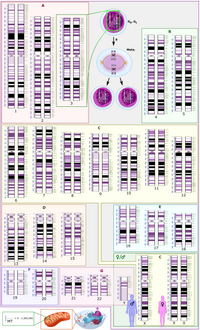
Photo from wikipedia
The human genome harbors 14,000 duplicated or retroposed pseudogenes. Given their functionality as regulatory RNAs and low conservation, we hypothesized that pseudogenes could shape human-specific phenotypes. To test this, we… Click to show full abstract
The human genome harbors 14,000 duplicated or retroposed pseudogenes. Given their functionality as regulatory RNAs and low conservation, we hypothesized that pseudogenes could shape human-specific phenotypes. To test this, we performed co-expression analyses and found that pseudogene exhibited tissue-specific expression, especially in the bone marrow. By incorporating genetic data, we identified a bone-marrow-specific duplicated pseudogene, HBBP1 (η-globin), which has been implicated in β-thalassemia. Extensive functional assays demonstrated that HBBP1 is essential for erythropoiesis by binding the RNA-binding protein (RBP), HNRNPA1, to upregulate TAL1, a key regulator of erythropoiesis. The HBBP1/TAL1 interaction contributes to a milder symptom in β-thalassemia patients. Comparative studies further indicated that the HBBP1/TAL1 interaction is human-specific. Genome-wide analyses showed that duplicated pseudogenes are often bound by RBPs and less commonly bound by microRNAs compared with retropseudogenes. Taken together, we not only demonstrate that pseudogenes can drive human evolution but also provide insights on their functional landscapes.
Journal Title: Developmental cell
Year Published: 2021
Link to full text (if available)
Share on Social Media: Sign Up to like & get
recommendations!